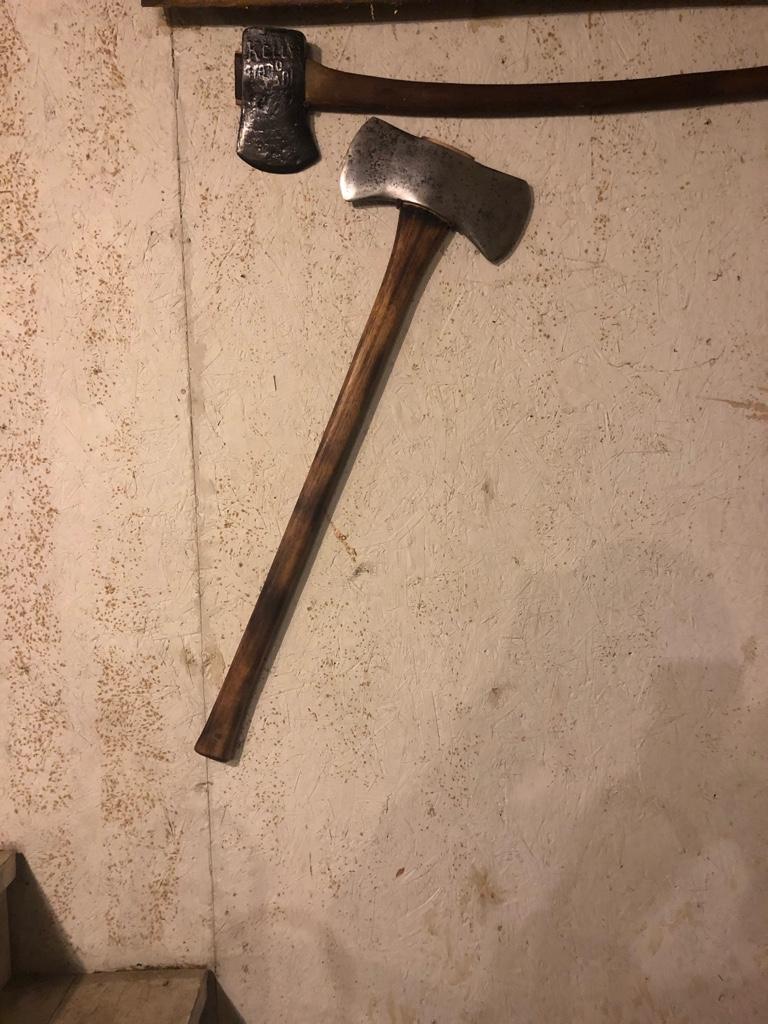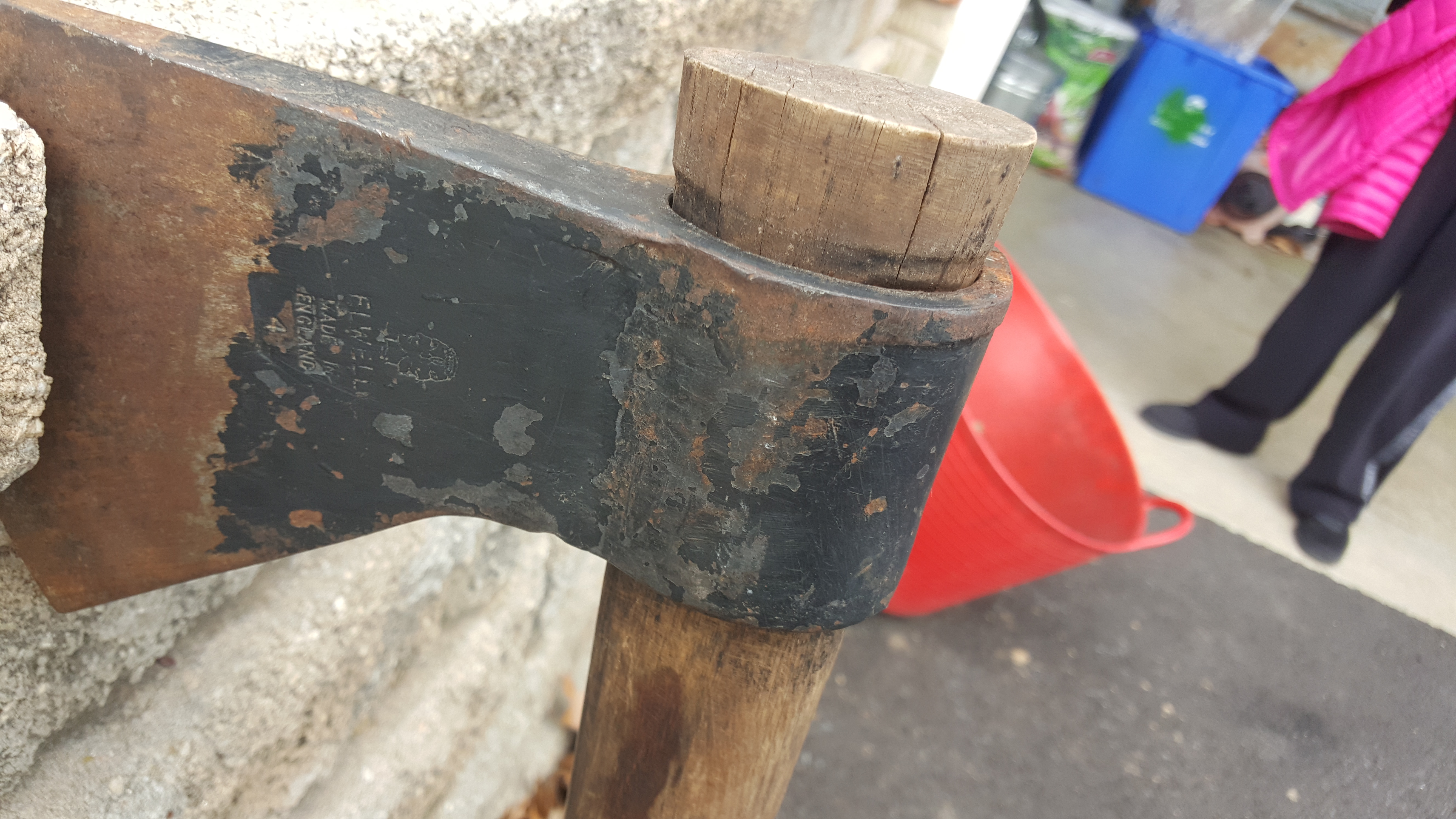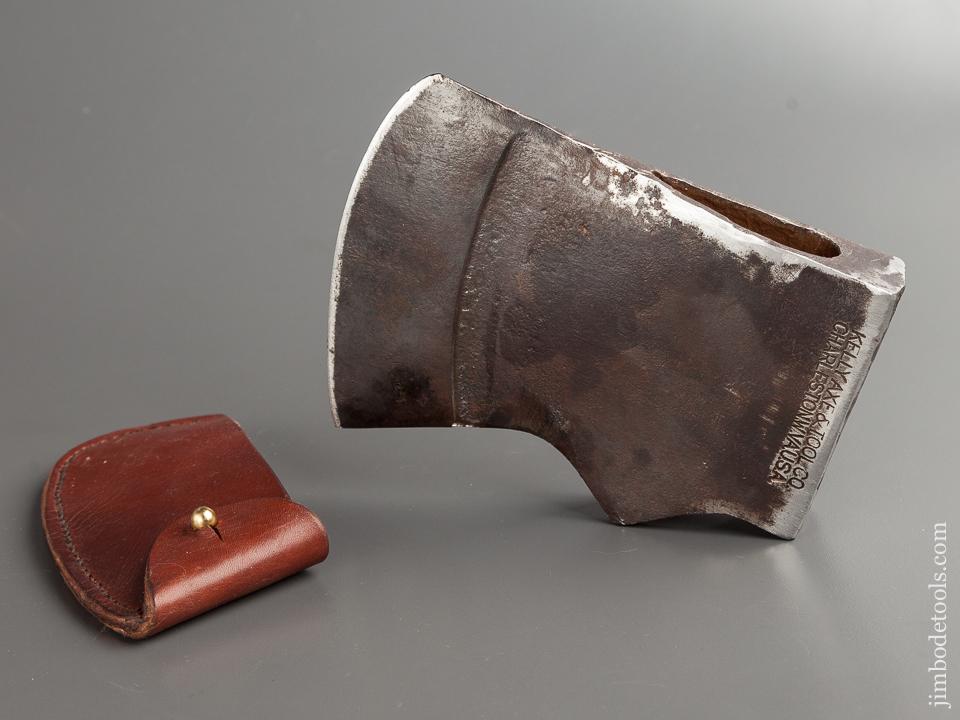That’s where I discovered it!!!
You are using an out of date browser. It may not display this or other websites correctly.
You should upgrade or use an alternative browser.
You should upgrade or use an alternative browser.
Axe restoration thread
- Thread starter svk
- Start date

Help Support Arborist Forum:
This site may earn a commission from merchant affiliate
links, including eBay, Amazon, and others.
Drptrch
Addicted to ArboristSite
I really like how the Watco oil finished the handle. Switched from BLO for last few axe builds.
Which Watco oil did you use ?
Sent from my iPhone using Tapatalk
I used medium walnut.
Kingbilly68
ArboristSite Lurker

My first axe restoration. True temper I found in an old garage.
Kingbilly68
ArboristSite Lurker

Before pic
I got out bid on some nice heads. One Collins with an absolute perfect poll, a double with two old hand planes, went to $50. I think the buyer wanted the old planes. Trouble with the online actions. I've got several nice axes because the person wanted the other items in the lot. Here's the four I brought home.









$202.29
Oregon Yukon Chainsaw Safety Protective Bib & Braces Trousers - Type A Protection, Dark Grey, Large
Express Shipping ⭐⭐⭐⭐⭐

$215.05
$233.19
Weaver Leather WLC 315 Saddle with 1" Heavy Duty Coated Webbing Leg Straps, Medium, Brown/Red
Amazon.com

$225.16
OREGON 295397 Type C (All Round Yukon Chainsaw Protective Trouser, Black, Small
Express Shipping ⭐⭐⭐⭐⭐

$56.99 ($0.38 / Foot)
$69.99 ($0.47 / Foot)
Arborist Rigging Rope Bull Rope Black (1/2 in x 150ft) Polyester Braided Arborist Rope 48 Strands for Tree Work Camping or Swinging…
UIERTIO

$19.99 ($3.33 / Count)
Firewood Log Splitter 45mm+32mm + 4 Handles (Square + Round + Hex Shank + Small Hex) Wood Log Splitter Easy Splitter Detachable Drill Bit Heavy Duty Electric Drills Screw Cone Driver Removable
JianShiMoQinDianZiShangWuYouXianGongSi

$26.99 ($0.22 / Foot)
$29.99 ($0.25 / Foot)
VEVOR Double Braided Polyester Rope, 1/2 in x 120 ft, 48 Strands, 8000 LBS Breaking Strength Outdoor Rope, Arborist Rigging Rope for Rock Hiking Camping Swing Rappelling Rescue, Orange/Black
Amazon.com

$59.99 ($0.40 / Foot)
$69.79 ($0.47 / Foot)
Arborist Rigging Rope 1/2 in x 150 Ft Blue Bull Rope Polyester Braided Arborist Rope 1/2 inch 48 Strands 150 Feet for Various Outdoor Applications Construction Climbing Swing Sailing
Glfcai store

$337.83
$369.99
WEN Electric Log Splitter, 6.5-Ton Capacity with Portable Stand (56208)
Amazon.com

$63.99
ZELARMAN Chainsaw Chaps Apron Wrap 8-layer for Men/Women Loggers Forest Workers Protective Chain Saw Pants Adjustable
QUALITY GARDEN & HAND TOOLS

$79.99
ZELARMAN Chainsaw Chaps 8-layer Protective Apron Wrap Adjustable Chainsaw Pants/Chap for Loggers Forest Workers Class A
QUALITY GARDEN & HAND TOOLS
This is probably the only ax I have with a proud handle.


You got the Elwell Inn the end then!
And you stuck it in a block wall!
Shows the quality of the steel
Thanks, you beat me to it. I was going to say it's one Bad Azz axe.Shows the quality of the steel
I like to know the history of my axes. I found quite a bit on Elwell going back to the 1500's.
I always thought the Stanley's were middle of the line quality axes, but I may be wrong. Mann Ax bought out Collins's holdings in the US in 1966. But, Stanley bought out their holdings in South America and Mexico. Stanley had a no compete clause in the purchase, so Mann could not market products with the Mann or Collins name on them south of the border. If you look at the pic of the Stanley, you can see an M at each end of the logo. Some of the Ax historians "think" that may stand for Mann Made, and Mann actually made the axes for Stanley. Just an educated guess.
I always thought the Stanley's were middle of the line quality axes, but I may be wrong. Mann Ax bought out Collins's holdings in the US in 1966. But, Stanley bought out their holdings in South America and Mexico. Stanley had a no compete clause in the purchase, so Mann could not market products with the Mann or Collins name on them south of the border. If you look at the pic of the Stanley, you can see an M at each end of the logo. Some of the Ax historians "think" that may stand for Mann Made, and Mann actually made the axes for Stanley. Just an educated guess.
I'm going to step on some toes again. But, that's just me. You guys are taking some beautiful heads, putting them on beautiful hafts, and not taking 5 minutes to learn how to hang them right. I have 100+ year old axes that were hung properly, with the original haft in them, cut flush to the eye, and they are still tight. To me, sticking a 1/4 to 1/2 inch out of the eye is just being too lazy to do it right. Trim the handle so it slides through easy then squash the wood to make it tight. You are going to find, if you use them, that because the part of the haft inside the eye is not tight to the eye, in time it will let the head slide into the squashed part and eventually come loose. It's like finding a beautiful Model A with a rust hole in the floor, and just screwing a piece of plywood over it. It's flat, it stops the water getting in, you can't see it, and it's easier than welding a proper patch in. I guess it's a BBR thing?
Wow, that thing is cool. The way you finished the top of the haft is beautiful. I can pass this chore on to you. In my early days of collecting, and playing on computers, I found a printed table of makers marks. I had been looking all day and had tried every combination of words I could think of for searches. I didn't know how to copy and print stuff, so I was waiting for my son to get home. When I went back later, someone else used the computer and erased my page. I tried using every combo of words, and have looked for that chart many times since, and have never found it. It must be out there somewhere? Good luck.
Just did a search for, "list of axe makers marks" and found a bunch of them, might take a while to go through them all.
I’ve been scanning the web for quite some time and have not been able to identify this axe by the “10” stamped under the bit. Kind of odd. It’s a huge axe.
Idk anything about it, but I don't think that's a 1.I’ve been scanning the web for quite some time and have not been able to identify this axe by the “10” stamped under the bit. Kind of odd. It’s a huge axe.
(I'm just following along for the education
1815 Netherlands?


http://www.nobelantik.dk/www/Fnetherlands_Date_Code.html
https://en.wikipedia.org/wiki/Dutch_colonization_of_the_Americas
You can see a 4 under the Elwell logo. I would assume that means a 4 pounds? The handle is quite heavy, the whole thing feels like 8-10 ponds. It's heavy, and I would not like to be on the user end all day!You got the Elwell Inn the end then!
That first axe is very old and I'd swear I've seen that "lip" at the edge before, but I can't remember where. It might have been called a "Chip Slinger" or something similar. edit: Yep, a Kelly Chip Slinger!I got out bid on some nice heads. One Collins with an absolute perfect poll, a double with two old hand planes, went to $50. I think the buyer wanted the old planes. Trouble with the online actions. I've got several nice axes because the person wanted the other items in the lot. Here's the four I brought home.





Stanley's are middle line. They were made by Mann, and Mann also made axes for Collins from the 60's onward. I have a beefy Stanley, it was my first single bit and it is a good user, but it has flat cheeks and isn't the greatest. It splits well, is a nice wedge-beater, and is made from good steel, but I wouldn't use it for felling or bucking. You can see it on the far right side of this picture.I like to know the history of my axes. I found quite a bit on Elwell going back to the 1500's.
I always thought the Stanley's were middle of the line quality axes, but I may be wrong. Mann Ax bought out Collins's holdings in the US in 1966. But, Stanley bought out their holdings in South America and Mexico. Stanley had a no compete clause in the purchase, so Mann could not market products with the Mann or Collins name on them south of the border. If you look at the pic of the Stanley, you can see an M at each end of the logo. Some of the Ax historians "think" that may stand for Mann Made, and Mann actually made the axes for Stanley. Just an educated guess.

I only recall hearing of two manufacturers with stamps on the bottom of the axe, one was an eastern company, either Snow and Neally or Emerson and Stevens, and the other was Mann so I'd guess it's a Mann. To the best of my knowledge, only Kelly, Warren, Mann, Sager, and maybe Plumb made Pugets in any real numbers, so it is almost definitely one of them at least. No, @TNTreeHugger I do not think it's Dutch. Americans were the only people to make large quantities of double bits, and we are the only nation to produce Puget Sound axes, so named because they were designed for the massive old growth trees in the PNW.I’ve been scanning the web for quite some time and have not been able to identify this axe by the “10” stamped under the bit. Kind of odd. It’s a huge axe.
Similar threads
- Replies
- 5
- Views
- 605
- Replies
- 69
- Views
- 4K
Want to Sell
Restored Pioneer 800 for sale
- Replies
- 5
- Views
- 402

















































